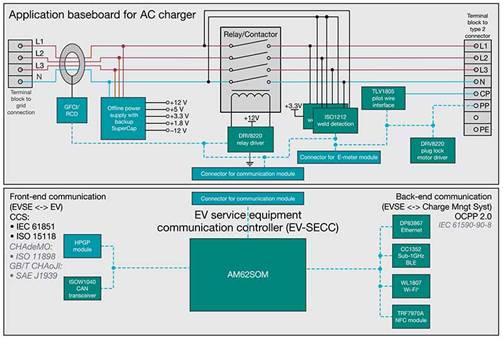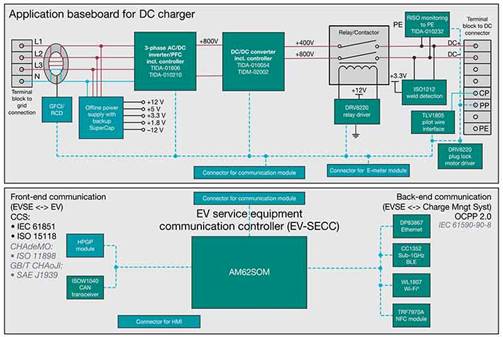Three design considerations for electric vehicle charging
Time:2022-09-11
Views:1686
Author: Texas Instruments
Typical electric vehicle (EV) charging station designs for commercial and residential uses include energy metering, residual current detection (AC and DC), isolation safety compliance, relays and contactors, as well as drive functions, two-way communication, and service and user interfaces. Although the goal of the charging station is to efficiently transmit power to the vehicle, achieving power transmission is only its initial function.
According to the latest report of IHS Markit, by 2030, it is estimated that 20 million public electric vehicle charging stations will be connected to the power grid, and the scale of community charging stations is expected to expand significantly to meet demand. Electric vehicle charging station design contains unique challenges. Electric vehicle supply equipment (evse) must combine communication, functional security and information security functions, and provide a simple upgrade path to adapt to future power grid integration. In this article, I will briefly introduce three design considerations for applying ti‘s sitaratm am625 to the class 2 AC electric vehicle charging station in the case of scalable hardware and software.
Design considerations 1: understand future communication standards and power grid integration
In the future, electric vehicles are expected to become an energy source, that is, to return stored electric energy to the grid during peak power consumption or power outages. Managing this potential energy exchange is an aspect of grid integration, which makes communication a key design consideration for electric vehicle charging stations. Whether it is from the vehicle charging point to the power grid or from the charging station to the cloud, the front and rear end communication design must meet the data, function security and information security standards during the charging process, as shown in Figure 1.

Figure 1: V2G Technology
The international organization for Standardization (ISO) 15118 Standard outlines the two-way communication protocol between electric vehicles and charging stations, which can exchange information such as vehicle identification, charging control and charging status, so as to realize plug and play functions. Including front-end and back-end communication requirements to meet the ISO 15118 standard, not only meets the compliance at present, but also realizes the long-term applicability of the design for future power grid integration.
By choosing appropriate processor integration and software functions at present, simple optimization can be realized for future power grid integration. As shown in Figure 2, sitaratm am625 used in the charging design of electric vehicles includes a mainline Linux with a standard software development kit ® Kernel, which can ensure efficient maintenance and simplify update. The am625 processor also supports safe startup to achieve IP protection, with a built-in hardware security module (HSM), and adopts advanced power management support to optimize the system power consumption when idle.




Fig. 2: block diagram of AC charger; DC charger block diagram
Design considerations 2: use module based design to realize flexible AC or DC charging options
Determining a suitable connection solution for electric vehicle chargers includes considering its use cases, installation environment and expansion for grid integration. Commercial electric vehicle chargers usually need cloud connection to manage billing, power distribution and vehicle data insight. You may need to consider the function of centralized data management among multiple charging points. The community charger will eventually become an extension of smart home, which needs to be integrated with existing wired and wireless networks.
The open charging protocol (ocpp) is a standard that defines communication between a charging station and a charging station network that manages data exchange. Designing for this protocol requires a variety of connection options, such as Ethernet, cellular and Wi Fi ® Or sub-1 GHz signal.
In order to meet the challenge of flexibly meeting ocpp, electric vehicle chargers need to have a variety of connection options. For example, WiFi is everywhere. Therefore, it can be used to connect electric vehicle chargers to existing infrastructure, or to provide local connection for a network of charging stations where wired connection is not feasible. When electric vehicle chargers are deployed in challenging RF environments such as underground parking lots, low-frequency communication such as Sub-1GHz is superior to LTE in connection reliability. Whether the design is for commercial or residential use, or where the charger is located, the design needs a flexible and reliable connection solution.
Choosing the right connection solution means supporting a higher operating temperature range and ensuring stable connection even in harsh environments with large temperature changes. In addition, ensure interoperability with business or home networks. Ti‘s wl1837mod wilinktm 8 module can provide excellent RF performance and strong interoperability with other WiFi devices. It also integrates Bluetooth for easy configuration and deployment. In combination with phyto-am62x multi-core arm that can be used for mass production ® Processor system level module, wl1837mod can provide ecosystem software compatibility, facilitate third-party software integration, and provide upgrade paths for future migration and optimization of ocpp 2.0.1 and higher versions.
Design note 3: manage life through information security and functional security options.
With the future development of ISO 15118 and ocpp 2.0.1 in the direction of improving data insight (for vehicle and user data), security software is essential for connection and communication. The processor will play a key role in realizing the scalability of electric vehicle charging in the future, not only as a system monitor for monitoring data quality and charging level, but also as a security gateway for in-depth understanding of payment and vehicle data.
Both the application layer and the transport layer of ISO 15118 support data security. Transport layer security (TLS) version 1.2 or higher encrypts transport layer communications. Although the TLS of ISO 15118-2 is mandatory only when the plug and play identification mechanism is used, TLS will be mandatory for all use cases and all identification mechanisms in the future ISO 15118-20 standard. Am625 has onboard HSM information security functions, such as:
• safe start:
• self programming hardware (eFuse) key.
• supports encrypted and authenticated startup.
• debug (joint action group) port.
• off by default on high security devices.
• the eFuse setting allows permanent shutdown.
Each EV charging design includes many safety aspects, including safety cable connection, ground fault monitoring, relay driving and high voltage isolation. Ti‘s drv8220 motor driver IC has integrated H-bridge, logic control and protection functions, which can easily realize plug locking, ground fault monitoring and relay driver.
epilogue
The electric vehicle charging industry continues to develop, becoming more standardized, intelligent and efficient. Designers must consider flexible connectivity and security to achieve long-term integration with the power grid. Choosing a suitable processor design needs to consider the growing demand for data processing and the need for reliable software stacks.
|
Disclaimer: This article is transferred from other platforms and does not represent the views and positions of this site. If there is any infringement or objection, please contact us to delete it. thank you! |











